Several talks have been going on regarding whether are aldehydes electron withdrawing or not. Here we will be studying about various views regarding the nature of aldehyde whether it is electron withdrawing or show inductive effect and its nature.
Aldehydes are electron withdrawing because they tend to withdraw electron from electron rich system. The reason is because of the presence of a more electronegative atom in its carbonyl structure which in turn leads to develop inductive effect.
Aldehyde and halogens come under electron withdrawing group due to their electronegativity and this electron withdrawing groups can be identified if there is a more electronegative atom present in the group which tends to withdraw electron from system making it deactivating. Aryl groups are electron donating by resonance and are electron donating by -I effect.
Due to the polar nature of aldehyde and also its inductive effect several doubts have been arising whether aldehyde is electron withdrawing or donating but once you go through this article most of your doubts regarding the nature of aldehyde will be solved
So, lets discuss about the facts in detail.
Are aldehydes electron withdrawing?
The answer for are aldehydes electron withdrawing is that yes, aldehydes are electron withdrawing groups because they withdraw electron from an electron rich carbanion (a species that contains a carbon atom bearing negative charge or rich in electrons)
For example, consider the image given below;
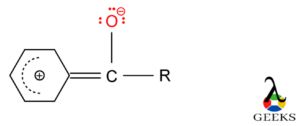
are aldehydes electron withdrawing; electron withdrawing nature of aldehyde
1) the more electronegative oxygen atom in the aldehyde group will tend to attract electron towards itself
2) A partial positive charge is developed on carbon due to electronegative oxygen atom
3) As a result of that the electrons released by benzene ring due to electron resonance effect tends to move towards positive carbonyl carbon
4)The electrons are withdrawn by the aldehyde group making the carbonyl carbon less effective towards nucleophilic attack
Why are aldehydes electron withdrawing?
It is regarded as a electron withdrawing compound because of the polarity in its carbonyl structure leading to develop a permanent dipole moment in the carbonyl compound.
To know why are aldehydes electron withdrawing Considering the C=O bond in aldehyde, the oxygen atom is far more electronegative than that of the carbonyl carbon and because of that the more electronegative oxygen will tend to withdraw the shared electron pair towards itself.
This will make the bonded adjacent carbonyl carbon electron deficient or positively charged ready to withdraw electrons and due to this Presence of this more electronegative oxygen atom make the aldehyde electron withdrawing.
This presence of more electronegative oxygen atom is also one of the reasons why the electron deficient carbonyl carbon act as a centre for nucleophilic attack.
When an aldehyde is bonded to benzene ring act as a meta directing group because of its electron withdrawing nature.
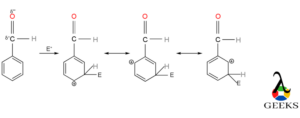
here the aldehyde group will decrease the electron density at ortho and para position and thus increase the availability of electron at meta position making it easy for electrophilic substitution
Does aldehyde show inductive effect?
Aldehyde does shows inductive effect the reason is due to the presence of an electronegative oxygen atom and an R group in the carbonyl compound which can be a hydrogen, alkyl or an aryl group.
Inductive effect is linked to the ability of substituents to either withdraw or donate electron density to the attached carbon atom. The displacement of sigma electrons permanently along a saturated carbon chain due to the presence of the electron withdrawing group (or donating group) is called inductive effect.
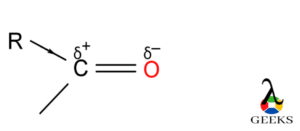
1) The group ‘R’ (can be alkyl, aryl or H) attached to the carbonyl carbon in aldehyde shows inductive effect and releases electron by +I effect or electron releasing effect (groups that donate electrons to the carbon chain).
2)Due to this reason the negative charge on oxygen atom is more intensified making the C=O more polar making the carbonyl carbon more electron deficient ready to be attacked by a nucleophile (electron rich compound).
Electron withdrawing effect
When dissimilar atoms take part in bond formation if a more electronegative atom is present then it will tend to withdraw the bonded electrons towards itself from the chain gives rise to inductive effect and then it is said to have electron withdrawing inductive effect (-I effect).
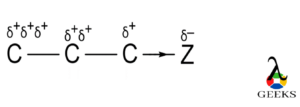
In Z atom Let’s say Z is a more electronegative atom than the adjacent carbon atom then the Z atom will attract the share electron pair towards itself causing a partial positive charge carbon atom and partial negative charge.
As electron withdrawing effect depends on distance ie, as distance increases -I effect decreases and as distance decreases -I effect increases so the carbons second and third will have less positive charge compared to first carbon
C1>C2>C3
It occurs only in bonds (occurs only in single bonds). Ie, only
electrons are shifted or withdrawn .
Some groups that show electron withdrawing effects are;
-CHO, -OH, -CN,-COOH etc
Electron withdrawing resonance effect is seen in substituted benzene.
They have the general formula C6H5-X=Y. Here Y is more electronegative than X.
Electron withdrawing effect of aldehyde
When an electron releasing group is attached to the aldehyde group as aldehyde is electron withdrawing so when the releasing group releases electron the aldehyde group will attract those electrons towards itself from the center making it deactivating.
The resonance structure of benzaldehyde is given as,
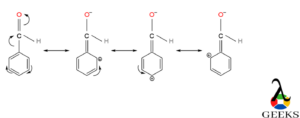
When a benzene ring is attached to -CHO group the electrons released through resonance by benzene ring decreases electron deficiency at carbonyl carbon thus deactivating the group and making it less reactive towards nucleophilic attack
How to identify electron withdrawing groups?
- Electron withdrawing group withdraws electron away from reaction center making it less reactive
- They are deactivating group. When an electron withdrawing group withdraws electron from the benzene ring because of that the reactivity of the benzene ring is decreased and therefore are known as deactivating group.
- Electron withdrawing group are meta directing. In an electrophilic substitution reaction the electrophiles are substituted in the meta direction of the benzene ring
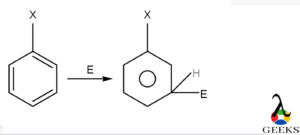
X=electron withdrawing group
E=electrophile
Lets look at the another picture,

Here if X is positively charged or if Y is more electronegative than X then the group is electron withdrawing
Eg, Halogens, nitriles, carbonyl compounds, nitro group etc.
Are carbonyls electron withdrawing?
Substituents with C=O bond i.e., aldehydes and ketones which are a carbonyl compound come under electron withdrawing group.
They are meta directing group because they decrease the electron density at ortho/para position in the ring by electron withdrawing resonance effect and because of that electron availability at meta position will be more compared to ortho or para position and therefore the electrophiles tend to attack at the meta position.
Are aryl groups electron withdrawing?
Aryl groups come under electron donating group.
Actually, the electron withdrawing inductive effect (-I effect) of the aryl group is expected to increase the electron deficiency at carbonyl carbon by withdrawing the electrons and thereby increase the nucleophilic attack at the carbonyl carbon
However, because of the electron withdrawing resonance effect of the benzene ring will decrease the electron density deficiency at the carbonyl carbon by releasing the electrons and because of that it deactivates the carbonyl group towards nucleophilic attack

Are halogens electron withdrawing?
Halogens also come under electron withdrawing group and are also deactivating but they are ortho or para directing.
the reason is its shows electron withdrawing inductive effect because of its electronegative nature also show electron donating resonance effect because of the presence of lone pair of electrons. The electron withdrawing inductive effect of this halogens make them a deactivating group.

The halogens tend to increase the electron density at ortho and para position of the ring due to its resonance effect and intensifying the attack of electrophile thus making it a ortho and para directing group
Hi..I am Lina Karankal, I have completed my Master’s in Chemistry. I always like to explore new areas in the field of Chemistry.
Apart from this, I like to read, travel and listen to Music.